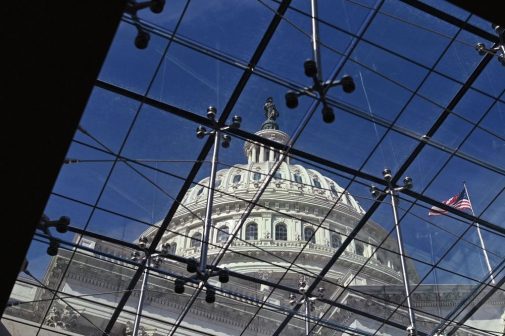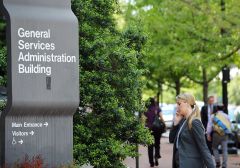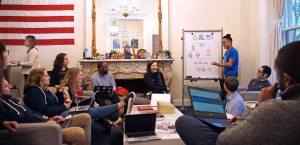Silicon Valley’s public service awakening — is it real?

Former U.S. Chief Technology Officer Todd Park now heads up the White House’s high-tech recruitment efforts in Silicon Valley. Is his call to public service working? (Photo illustration by Emma Whitehead/FedScoop)
This is the first in a series of occasional stories exploring the evolving relationship between the technology industry and government.
It may not go down as one of the great population migrations in history, but there’s no doubt Silicon Valley has arrived in Washington, D.C. After years of watching long-time government officials leave public service for lucrative gigs in the private sector, the trend seems to be reversing with big names in tech parachuting into the nation’s capital on a regular basis to help save government from itself.
But observers and commentators have spent the better part of the last year focusing on where this new wave of tech talent originated — Google, Twitter, IBM, Amazon, Microsoft, PayPal and eBay, as well as a healthy sprinkling of Palo Alto-area Web designers and Obama social media apparatchiks turned presidential innovation fellows. The questions that haven’t been explored, on the other hand, are arguably far more important to the long-term impact of this new influx of tech talent. Why is it happening, and why now? And what do the motivations of this pool of largely 30something-years-old self-described geeks say about the changing perception of national service?
The easy answer would be to chalk up the trend to President Barack Obama’s 2008 campaign, which introduced the nation to the power of social media in the hands of a generation long thought to have become disconnected with the real, nonvirtual world we all live in. DJ Patil, the latest Silicon Valley entrepreneur to join government as the nation’s first chief data scientist, took this approach in a recent blog posting. “As a data scientist, one thing I can guarantee is that this is the most data-driven President we’ve ever had,” Patil wrote.
The other easy answer would be to say it’s really all about the money and the influence — Google and Twitter are big Obama donors and want influence. But the “Obama is cool and he owes us” answer doesn’t explain the arrival of Megan Smith from a top gig at Google to become the U.S. chief technology officer and dozens of other lesser-known left coasters who now fill the ranks of the U.S. Digital Service. And it certainly doesn’t guarantee that just because the revolving door between Washington, D.C., and Silicon Valley is suddenly spinning in the opposite direction that it will succeed and result in lasting change.
A new call to service?
There is no shortage of intractable challenges in the world toward which young, idealistic millennials can direct their boundless energy — global warming, poverty, homelessness, hunger and childhood diseases are usually the big draws for obvious reasons. But becoming a bureaucrat in big government? That’s a new one.
Yet the movement to government service from the high-tech community is actually just a new wrinkle in a fabric as old as the nation itself. Those who fought and won America’s independence were volunteers, and private industry writ large contributed to the national mobilization to defeat Nazism. In the 1930s, the Civilian Conservation Corps offered those who saw little hope in the shadow of the Great Depression an opportunity to earn an income while contributing to building America’s infrastructure. Today, there’s the Corporation for National and Community Service, which runs the AmeriCorps program. But does the newly formed U.S. Digital Service fall into the same category as these historic and transformative initiatives?
One look at the language used on the USDS recruiting website and by its founding members shows that the answer to that question — as far as they’re concerned — is a resounding yes. People are suffering, and many blame government’s inability to function efficiently and effectively. The American breed of dysfunctional, clumsy and inflexible government has become the new intractable problem that no serious tech innovator open to new challenges can ignore.
“We need people like you to take on these high-stakes challenges” in the service of millions, the USDS website says. The USDS is where America’s “most capable problem solvers” can work on “thorny” issues that touch everyday lives and, if successful, can effect “change at scale,” states the website’s recruitment page.
But will the stories of the USDS survive the test of time the way the great stories of national sacrifice have? Will children gather around the table to listen to their grandparents talk about how they helped rescue a website from an army of bad coders and inept bureaucrats? Will that be enough to encourage a new generation of selfless technologists to volunteer?
Mikey Dickerson thinks so. “These tours of duty that we set people up with, these are things that they’re going to be telling their grand kids about,” said the former Google engineer who helped rescue the Healthcare.gov rollout and now serves as the administrator of the USDS.
“I finally get to use my skills to actually make a difference in peoples’ lives and I think a long-term difference,” said Healthcare.gov engineer Eric Maland, a former Amazon engineer and operations director at Twitter.
“I thought about this and I just remember thinking, wow, I know technology; this is how I’ll serve my country,” said Kathy Pham, a USDS health data expert.

Mikey Dickerson, administrator of the U.S. Digital Service. (White House)
Why now?
The desire to serve is certainly a major factor in the decision to work in government, but it alone does not explain how or why the situation hit a critical mass for the technology community at this time. Some see socio-economic drivers behind the shift. Is the U.S. Digital Service really the result of a hacktivist movement born out of deep frustration with government and changes in the economy?
Molly Sauter, a fellow at the Berkman Center for Internet and Society at Harvard Law School, said hacktivist groups form out of “longstanding, cultural level grievances” that reach a boiling point that then incites people to take action. “That’s when you get this spark and things start to congeal very rapidly,” she said, speaking Feb. 23 at the Cybersecurity for a New America conference in Washington, D.C.
But could it also be as simple as the economy? Are the digital tea leaves of the changing economy just pointing these technology hotshots to a future outside of the traditional tech industry and, as a result, a future divorced from Silicon Valley? That’s exactly what some business analysts believe. Recent research by Arlington, Virginia-based consulting firm CEB, for example, shows that while the traditional tech hubs have been thought of as the growth engine for IT jobs, that’s no longer the case.
“Only 34 percent of the total U.S. IT workforce is located in traditional locations like Seattle and Silicon Valley and IT job growth projects through 2018 are expected to grow faster in emerging cities like D.C., Philadelphia, Denver and Atlanta,” according to a study by the firm. “This increased competition for IT talent is creating a new employee supply gap that is forcing organizations, including the public sector, to think beyond traditional geographic talent pools and candidate profiles to acquire and retain top IT employees.”
Nathaniel Fick, the chief executive officer of security intelligence and analytics firm Endgame, said the job market may not look like it once did and the dynamics of the workforce may seem alien compared to a decade ago, but people still accept and quit jobs for the same reasons they always have.
“Why do people join a team? They want purpose,” Fick said, speaking at a recent event hosted by the New America Foundation in Washington, D.C. “They want to know what they’re doing matters. And they don’t want to be screwed with. They want autonomy. People quit because they don’t like their boss. The average tenure for a millennial is two years. It’s a highly mobile workforce,” Fick said, referring not to the devices they carry but to a willingness to move from job to job in search of meaning, purpose and a true sense of belonging to a dedicated team.
Even the Army — known for its need to abide by military discipline and structure — is experiencing a swell of interest in its developing cyber operations, according to the head of the Army’s Cyber Command Lt. Gen. Edward Cardon, who also spoke at the Cybersecurity for a New America conference. The Army had to wade through more than 1,100 applications for just 300 officer positions in its first round of recruiting for Army Cyber Command, he said. The service filled 75 percent of its cyber positions in the first quarter without the need for any additional career incentives.
“The importance of mission … the people you are around … that is a really compelling factor,” Cardon said, acknowledging that many technologists are likely positioning themselves for a career in the private sector. “I see much more of a gamer mentality being used now.”
But even “aggressively horizontal organizations have leadership structures just like any other organization,” Sauter said. “There’s always bureaucracy in these types of organizations. You often can’t see it. There are always core organizers. That’s a very small core.”
Who’s calling who?
Does the current Silicon Valley to D.C. movement have a core group of organizers at the helm? It’s hard to say, primarily because the shift is so far out of character for both sides of the public-private equation.
Citizens may be calling on their government to improve its performance in the service of the nation, and Silicon Valley’s technologists may be part of that effort. But Ben Balter, the government evangelist at GitHub — the world’s largest software development network — and a member of the inaugural class of Presidential Innovation Fellows in the White House, said while the need for Silicon Valley talent in government has long existed, the real key is that government is finally asking for help.
“The government, for the first time, is asking and is asking in a big way,” Balter said.
But the shift runs even deeper than that, he said. In the past, government job sites were notoriously difficult to navigate and would describe something as simple as a website as an “agencywide enterprise digital engagement platform.” Getting young tech talent to even consider exploring such a position, not to mention hired and through the vetting process, has been extremely difficult, he said.
“But all that’s changing,” Balter said. “To paraphrase a West Coast adage, the best minds of our generation are figuring out how to get people to click ads. Public service offers an attractive alternative, and if we can get the barrier to entry low enough, we may be able to tap into civic talent’s sense of civic duty.”
The Presidential Innovation Fellows initiative was the first of these efforts, Balter said, enticing digital entrepreneurs to serve their country for six months to a year. Today, members of the USDS and other government leaders talk in terms of even shorter periods of service, sometimes weeks.
“It’s no longer an all-or-nothing proposition if I want to serve my country. In the case of [the General Services Administration’s] 18F, which has team members in each time zone, you’ll likely even be able to do it without moving your family across the country,” Balter said. “It’s the Peace Corps or Army Reserve for geeks, and it’s having a big impact on how we approach technology in D.C.”

Former U.S. CTO Todd Park briefing President Barack Obama.
White House West?
There’s one other key aspect to the Obama administration’s newly found success in recruiting Silicon Valley execs to government that has gone relatively unnoticed in recent months — the White House has put down roots in the Valley and has dispatched a new recruiter-in-chief to lead the hiring charge.
Move over Uncle Sam — Uncle Todd is the star of the Silicon Valley recruitment poster.
Last year, Todd Park left his post as U.S. chief technology officer to become the administration’s point man on tech recruitment based in California. In private conversations, colleagues credit Park’s personal touch and a tenacious effort — visiting with sought-after candidates at their homes and inviting them to his home — to sell the government service pitch to a generation known more for a cliquish, smartphone view of the world and less for its willingness to sacrifice individual achievement for the greater good.
To date, the nature and the details of Park’s pitch to the nation’s techies has been unclear. But he’s obviously a closer and, if you listen closely to current members of the USDS team talk about why they joined, the likely main selling points of the pitch ring through.
Maland, the former Amazon and Twitter engineer, uses words like “because it matters” when describing his reason for jumping into a situation that many in the private sector view as a lost cause. Dickerson talks about his real customers — the American people — in terms like “the most in need” or “least able to help themselves.”
Sarah Allen, a product lead on the 18F team, talks about shifting “how people are working, facilitated by technology” and watching those shifts “outlast the specific technical solutions that we build.” And while it is not, as Allen puts it, an “unparalleled” opportunity in history, the potential to effect long-lasting change seems to resonate with those technologists who choose to serve.
In his Feb. 25 White House blog posting, Patil also makes an appeal to the better nature of Silicon Valley’s tech angels and even calls on the community to “step up” in a Tweet promoting the posting. “If we’re really going to make the world better through data, it’s going to take all of us,” wrote Patil, who hails from the likes of LinkedIn, eBay and PayPal. “So, here’s my call to those of you in the tech and data sectors: We need your help. Come on and join in and help make our country better.”

DJ Patil, the nation’s first chief data scientist, recently called on his Silicon Valley colleagues to “step up” to government service.
Even Megan Smith seems to have Uncle Todd’s “we want you!” pitch down to a science. In fact, she takes it to another level altogether, depicting the USDS as an emergency room team of surgeons and specialists who can be “scrubbed-in … together in these fabulous cross-functional teams” on a moment’s notice to save a life. “Some people are hands-on keyboard coders. There’s also amazing designers,” Smith said. “There’s amazing design-thinking people, there’s product managers. So, you may not think you belong in the United States Digital Service, but we want you,” she said, pointing her finger at the camera.
These are major, tectonic shifts. But they are only the beginning, according to Balter. “The White House is starting to build a presence out on the West Coast in an attempt to fold the map in half a bit and bring the two coasts together. 18F having an office out there and former CTO Todd Park serving as an adviser to lead recruitment efforts are just the start,” he said. “I wouldn’t be surprised if we didn’t see a more formal White House presence out west in the years to come.”
Is it real, will it work?
Former GSA Administrator Martha Johnson told FedScoop that while the influx of Silicon Valley talent into government is generally a good thing, real change will require more. “I hope it means that [Silicon Valley] types are ready to tackle the hard problems and not just the sexy ones,” Johnson said. At the top of Johnson’s list of hard problems facing government? “Innovation in government as a culture issue, not a tech issue only.”
That is certainly a tougher challenge, but there are nascent signs that even the overly risk-averse federal bureaucracy wants change and will stop at nothing to achieve it. And it has been that spark that some say has kick-started the procession of Silicon Valley hacktivists toward government.
“There is a thirst for innovation in the federal government that doesn’t yet rival Silicon Valley, but the scale of impact does,” Bill Annibell, chief technology officer at Sapient Government Services, told FedScoop. “Many of the best technologists and creative talent are cause-centric and are realizing the government’s move from paper-based transactions to more digital engagement allows them to work for the cause instead of the coin. This surge in innovation provides a platform for Silicon Valley techies to add to meaningful, impactful projects that are being developed to improve the citizen experience.”
But the fire that Todd Park has ignited throughout the Valley can still lose its heat if government falls back to its old ways and fails to keep this new crop of tech innovators motivated with a feeling of empowerment and room to fail.
“The trend will quickly fade if the best talent is stalled by the lack of speed or inability to enact change,” Annibell said. “Innovative ideas from Silicon Valley are very applicable within the space, but a change in the culture and a quicker innovation cycle is needed for those ideas to stick.”




